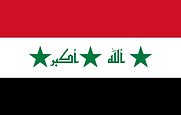UA Neo Fonts
The UA Neo fonts were the first revival of Unified Arabic type introduced by Nasri Khattar in the 1950s....

Blue Quran leaf
Although this example is dated back to the 9th or 10th century, the Kufic script developed around the 7th century. The estimated origin of the manuscript is around North Africa and the
Middle East.
This leaf is part of a bigger collection known as the Blue Quran. The materials used in this example are dyed vellum and gold ink. The use of dyed vellum is rare but the most common color used was yellow. The blue dye symbolizes wealth and rivals the most luxurious manuscripts of the Byzantine empire.
The script is categorized by angular and long strokes. The letters were shaped in a way that looks good written on parchment, buildings and decorative objects like ceramics and coins.
Iraqi flag
The Iraqi flag had many variations over the years. It didn't start incorporating typography until the design made in 1991. The 1991 version contains the phrase Allahu akbar, meaning God is great" in Arabic in Saddam Hussein's handwriting. It was said that the addition of sacred Islamic text was used to stop the disrespect of the flag during wartime.
In 2004 the script was replaced with Kufic script. It was the traditional preferred script style. The script originated in Kufa, which was the most important city in the Islamic period and was known for
its calligraphy.
_svg.png)
1991 - 2004
_svg.png)
2004 - 2008

2008 - present